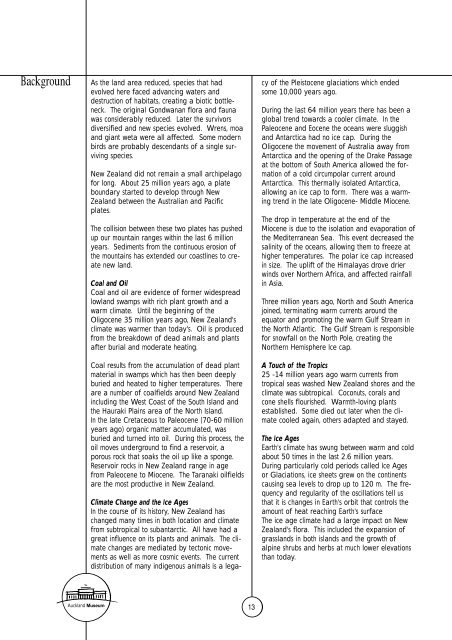Wanted: Oscar Obsidian - Auckland Museum
Wanted: Oscar Obsidian - Auckland Museum
Wanted: Oscar Obsidian - Auckland Museum
Create successful ePaper yourself
Turn your PDF publications into a flip-book with our unique Google optimized e-Paper software.
Background<br />
As the land area reduced, species that had<br />
evolved here faced advancing waters and<br />
destruction of habitats, creating a biotic bottleneck.<br />
The original Gondwanan flora and fauna<br />
was considerably reduced. Later the survivors<br />
diversified and new species evolved. Wrens, moa<br />
and giant weta were all affected. Some modern<br />
birds are probably descendants of a single surviving<br />
species.<br />
New Zealand did not remain a small archipelago<br />
for long. About 25 million years ago, a plate<br />
boundary started to develop through New<br />
Zealand between the Australian and Pacific<br />
plates.<br />
The collision between these two plates has pushed<br />
up our mountain ranges within the last 6 million<br />
years. Sediments from the continuous erosion of<br />
the mountains has extended our coastlines to create<br />
new land.<br />
Coal and Oil<br />
Coal and oil are evidence of former widespread<br />
lowland swamps with rich plant growth and a<br />
warm climate. Until the beginning of the<br />
Oligocene 35 million years ago, New Zealand's<br />
climate was warmer than today's. Oil is produced<br />
from the breakdown of dead animals and plants<br />
after burial and moderate heating.<br />
Coal results from the accumulation of dead plant<br />
material in swamps which has then been deeply<br />
buried and heated to higher temperatures. There<br />
are a number of coalfields around New Zealand<br />
including the West Coast of the South Island and<br />
the Hauraki Plains area of the North Island.<br />
In the late Cretaceous to Paleocene (70-60 million<br />
years ago) organic matter accumulated, was<br />
buried and turned into oil. During this process, the<br />
oil moves underground to find a reservoir, a<br />
porous rock that soaks the oil up like a sponge.<br />
Reservoir rocks in New Zealand range in age<br />
from Paleocene to Miocene. The Taranaki oilfields<br />
are the most productive in New Zealand.<br />
Climate Change and the Ice Ages<br />
In the course of its history, New Zealand has<br />
changed many times in both location and climate<br />
from subtropical to subantarctic. All have had a<br />
great influence on its plants and animals. The climate<br />
changes are mediated by tectonic movements<br />
as well as more cosmic events. The current<br />
distribution of many indigenous animals is a lega-<br />
<strong>Auckland</strong> <strong>Museum</strong> 13<br />
cy of the Pleistocene glaciations which ended<br />
some 10,000 years ago.<br />
During the last 64 million years there has been a<br />
global trend towards a cooler climate. In the<br />
Paleocene and Eocene the oceans were sluggish<br />
and Antarctica had no ice cap. During the<br />
Oligocene the movement of Australia away from<br />
Antarctica and the opening of the Drake Passage<br />
at the bottom of South America allowed the formation<br />
of a cold circumpolar current around<br />
Antarctica. This thermally isolated Antarctica,<br />
allowing an ice cap to form. There was a warming<br />
trend in the late Oligocene- Middle Miocene.<br />
The drop in temperature at the end of the<br />
Miocene is due to the isolation and evaporation of<br />
the Mediterranean Sea. This event decreased the<br />
salinity of the oceans, allowing them to freeze at<br />
higher temperatures. The polar ice cap increased<br />
in size. The uplift of the Himalayas drove drier<br />
winds over Northern Africa, and affected rainfall<br />
in Asia.<br />
Three million years ago, North and South America<br />
joined, terminating warm currents around the<br />
equator and promoting the warm Gulf Stream in<br />
the North Atlantic. The Gulf Stream is responsible<br />
for snowfall on the North Pole, creating the<br />
Northern Hemisphere Ice cap.<br />
A Touch of the Tropics<br />
25 -14 million years ago warm currents from<br />
tropical seas washed New Zealand shores and the<br />
climate was subtropical. Coconuts, corals and<br />
cone shells flourished. Warmth-loving plants<br />
established. Some died out later when the climate<br />
cooled again, others adapted and stayed.<br />
The Ice Ages<br />
Earth's climate has swung between warm and cold<br />
about 50 times in the last 2.6 million years.<br />
During particularly cold periods called Ice Ages<br />
or Glaciations, ice sheets grew on the continents<br />
causing sea levels to drop up to 120 m. The frequency<br />
and regularity of the oscillations tell us<br />
that it is changes in Earth's orbit that controls the<br />
amount of heat reaching Earth's surface<br />
The ice age climate had a large impact on New<br />
Zealand's flora. This included the expansion of<br />
grasslands in both islands and the growth of<br />
alpine shrubs and herbs at much lower elevations<br />
than today.











